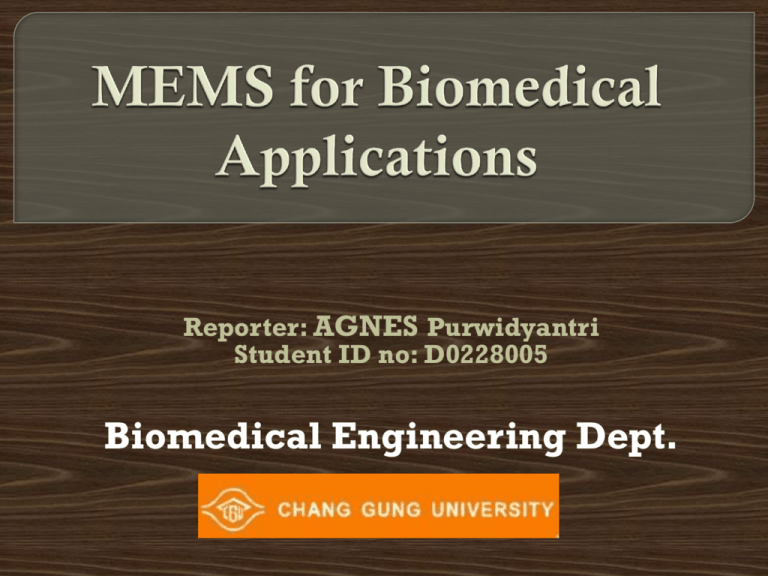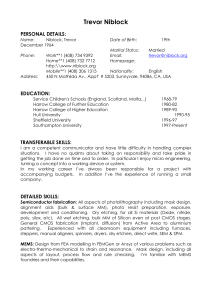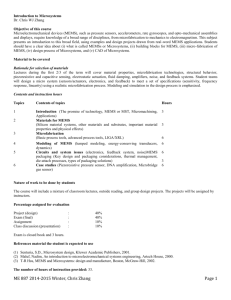MEMs for Biomedical Applications
advertisement

Reporter: AGNES Purwidyantri Student ID no: D0228005 Biomedical Engineering Dept. What are MEMS? [1] •Micro-Electro-Mechanical Systems (MEMS) is the integration of mechanical elements, sensors, actuators, and electronics on a common silicon substrate through microfabrication technology. •Microfabrication of silicon-based structures is usually achieved by repeating sequences of photolithography, etching, and deposition steps •Microelectronics fabrication techniques routinely produce well-controlled features that range in size from millimeters to submicrometers, while soft lithography techniques were recently used to produce features below 100 nm. Accelerometers • (Inertial Sensors – “Crash Bags”, Navigation, Safety) Ink Jet Print Heads Micro Fluidic Pumps • Insulin Pump (drug delivery) Pressure Sensor • Auto and Bio applications Spatial Light Modulators (SLM’s) • MOEM – Micro Optical Electro Mechanical Systems • DMD – Digital Mirror Device • DM – Deformable Mirror Chem Lab on a Chip • Homeland security RF (Radio Frequency) MEMS • Low insertion loss switches (High Frequency) Mass Storage Devices Typical process flow for IC manufacturing. [2] Differences with MEMS manufacturing are in bold italics 1987 TRW NovaSensor Accelerometer First generation inertial sensor Poppy seed is on top to show scale. Airbag3.avi Analog Devices – 1993 Saab was the first automobile company to include MEMS accelerometers to trigger airbags. Combined standard CMOS technology with MEMS fabrication MEMS-based systems answered the call of government regulated passive restraints in automobiles where these systems sensed rapid deceleration and in the event of a collision sent a signal to inflate rapidly an airbag. Surface Micromachining takes off in the 1990’s. (Sandia National Laboratories) This basically consists of alternating layers of structural materials (poly crystalline silicon) and sacrificial layers (Silicon Dioxide). The sacrificial layer is a scaffold and acts as a temporary support and spacing material. The last step of the process is the “release” step, where the sacrificial layer is removed freeing the structural layers so they can move. Micro Optical Electro Mechanical Systems “MEMS or Microsystems have the potential of having a greater impact on global business and society than did the computer chip.” - TI Development started 1980’s, first commercial product - 1996 MEMS needle within the opening of a small hypodermic needle Smaller size reduces pain and tissue damage – now there are much smaller MEMS needle arrays. The plastic needle array is made through a standard MEMS fabrication process to make the molds, micro injection process is used to create the arrays. Procter and Gamble Plastic Needle Array The Overlap between microbiology and microsystem feature sizes makes integration between the two possible Nucleus Eukaryotic cells 100 µm Ribosome Bacteria 10 µm Surface Micromachinin g Features (MEMS) Viruses 1 µm Visible Light 0.1 µm Gate of Leading Edge Transistor Proteins 0.01 µm (10 nm) 0.001 (1µm nm) Molecules Atom Lab on a chip/ smart prosthesis Advantages: Biocompatability Greater reproducibility+reliability Miniaturized implants Rapid Ability to provide electrical stimulus Chemical functionalization (tissue eng) Miniaturized Low cost Integration of sensor, actuators and electronics Interaction with fluids (microfluidics TAS, biochemical sensors) etc •A large variety – difficult to classify • Patient viewpoint: – diagnostic microsystems: rapid point-of-care, systems on a chip, cell and molecule sorting, DNA diagnostics – surgical microsystems: MIS (minimally invasive surgery), CADassisted surgery - microrobotics – therapeutic microsystems + prostheses: drug and gene delivery, tissue augmentation/repair, biocapsules, micro/minimally invasive surgical systems • The scale of the application: body level (drug delivery, tools for microsurgery, pacemakers, neural probes), analysis of body fluids (“Lab-on-a-chip” for blood analysis, glucose monitoring, electrophoresis), tissue and cell analysis, genomics (DNA microarrays) and proteomics (protein identification and characterization) • Biggest promise: better outcome for the patient and a lower overall health and cost Micro Total Analysis System •Micro ELISA •Micro FACS •Micro mass-spectrometer Micro Biomedical System •Micro syringe •Micro CSF shunt •Drug delivery bio-chip •Immunosensing bio-chip •Micro cell chip MEMS cantilevers as biosensors [3] Gold dot = 40nm SiN thickness = 90nm By changing the coating (Nano) one can functionalize the cantilever to detect single strands of DNA. Mass resolution is on the order of under 1 ato gram (10-18grams) 5 x 15um Cantilever with an E. Coli cell bound to immobilized antibody layer. Black is the response before cell attachment, Red is after cell attachment. School of Applied and Engineering Physics and the Nanobiotechnology Center, Cornell University MEMS cantilevers as biosensors Origin of nanomechanical cantilever motion generated from biomolecular interactions: Bio-MEMS Polymer/Si Cantilevers Sensors [7] References 1. 2. 3. 4. 5. 6. 7. Grayson A.C. R et al. 2004. A BioMEMS Review: MEMS Technology for Physiologically Integrated Devices. Invited Paper. IEEE Proceeding 92 (1). Vemal, R., Lo, C., Ong, S., Lee, B. S and Yong, C. C. 2009. MEMS vs. IC Manufacturing: Is Integration Between Processes Possible.1st Int'l Symposium on Quality Electronic Design-Asia. IEEE 2009 Hubler, U et al. 2003. Reprint from BioWorld http://www.hgc.cornell.edu/Nems%20Folder/Enumeration%20of %20Single%20DNA.html http://www.news.cornell.edu/releases/April04/attograms.ws.html Kristein, K. U et al. Cantilever-Based Biosensors in CMOS Technology. Physical Electronics Laboratory, ETH Zurich, Switzerland. Hit, Z. et al. 2002. Applied Physics Letters 81 (16): 3091-3093. Thank You





